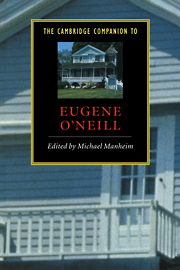Book contents
- Frontmatter
- Introduction
- 1 Celebrant of loss: Eugene O'Neill 1888-1953
- 2 O'Neill's philosophical and literary paragons
- 3 O'Neill and the theatre of his time
- 4 From trial to triumph: the early plays
- 5 The middle plays
- 6 The late plays
- 7 Notable American stage productions
- 8 O'Neill on screen
- 9 O'Neill's America: the strange interlude between the wars
- 10 O'Neill's African and Irish-Americans: stereotypes or “faithful realism”?
- 11 O'Neill's female characters
- 12 "A tale of possessors self-dispossessed"
- 13 Trying to write the family play: autobiography and the dramatic imagination
- 14 The stature of Long Day's Journey Into Night
- 15 O'Neill and the cult of sincerity
- 16 O'Neill criticism
- Select bibliography of full-length works
- Index
14 - The stature of Long Day's Journey Into Night
Published online by Cambridge University Press: 28 May 2006
- Frontmatter
- Introduction
- 1 Celebrant of loss: Eugene O'Neill 1888-1953
- 2 O'Neill's philosophical and literary paragons
- 3 O'Neill and the theatre of his time
- 4 From trial to triumph: the early plays
- 5 The middle plays
- 6 The late plays
- 7 Notable American stage productions
- 8 O'Neill on screen
- 9 O'Neill's America: the strange interlude between the wars
- 10 O'Neill's African and Irish-Americans: stereotypes or “faithful realism”?
- 11 O'Neill's female characters
- 12 "A tale of possessors self-dispossessed"
- 13 Trying to write the family play: autobiography and the dramatic imagination
- 14 The stature of Long Day's Journey Into Night
- 15 O'Neill and the cult of sincerity
- 16 O'Neill criticism
- Select bibliography of full-length works
- Index
Summary
What Richard Sewall suggests is the most salient characteristic of true tragedy is not its plots, themes, or subjects so much as the range of human feeling it incorporates in a single work, notably the “capacity for suffering” and the “stamina” of its central figures. To this I would add that it is not suffering and stamina alone, important as these qualities are in tragedy, which contribute to the greatness of a work but also the range of often contradictory feelings underlying the characters' statements and actions. In Sophocles' Antigone, it is not Antigone's monumental courage and fortitude in insisting on her brother's burial that contributes to our sense of who she is so much as it is that courage and fortitude set next to her equally monumental rigidity. Her heroism does not rule out this rigidity nor does the rigidity discredit the heroism. It is in taking those qualities together that we come to see her as tragic.
- Type
- Chapter
- Information
- The Cambridge Companion to Eugene O'Neill , pp. 206 - 216Publisher: Cambridge University PressPrint publication year: 1998

